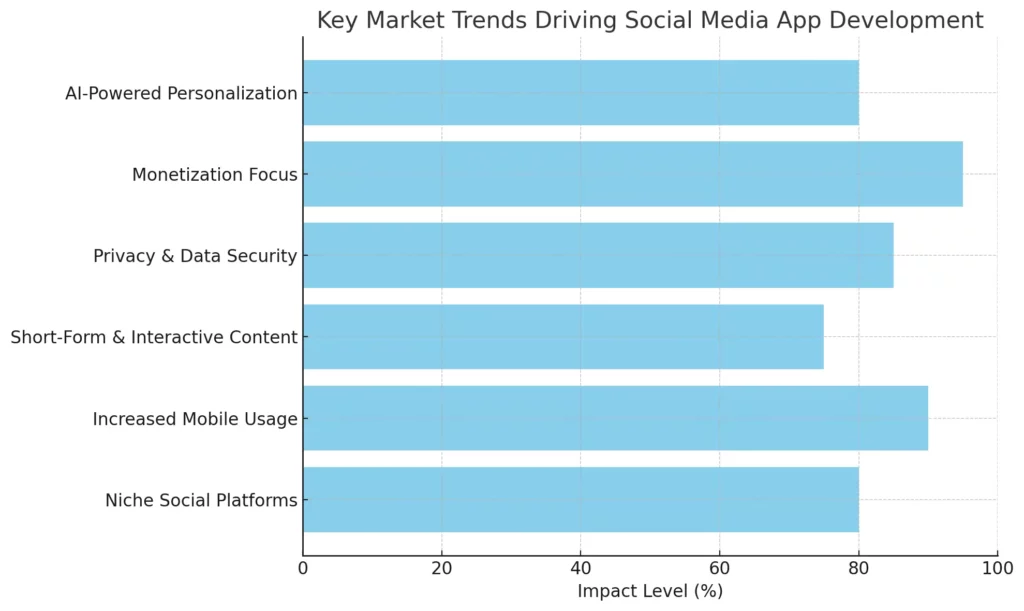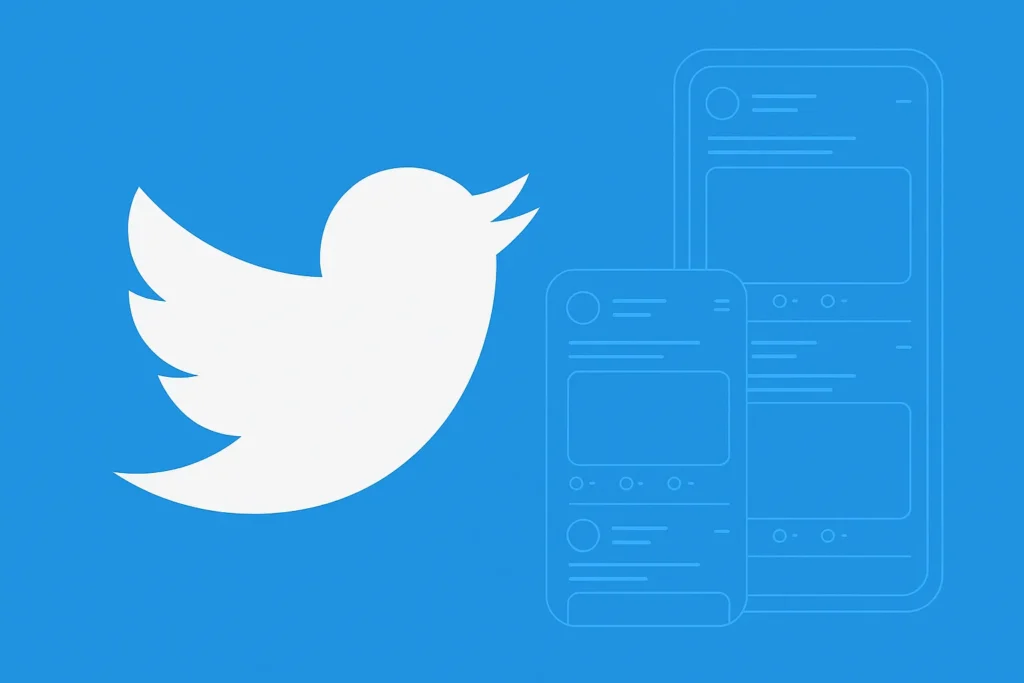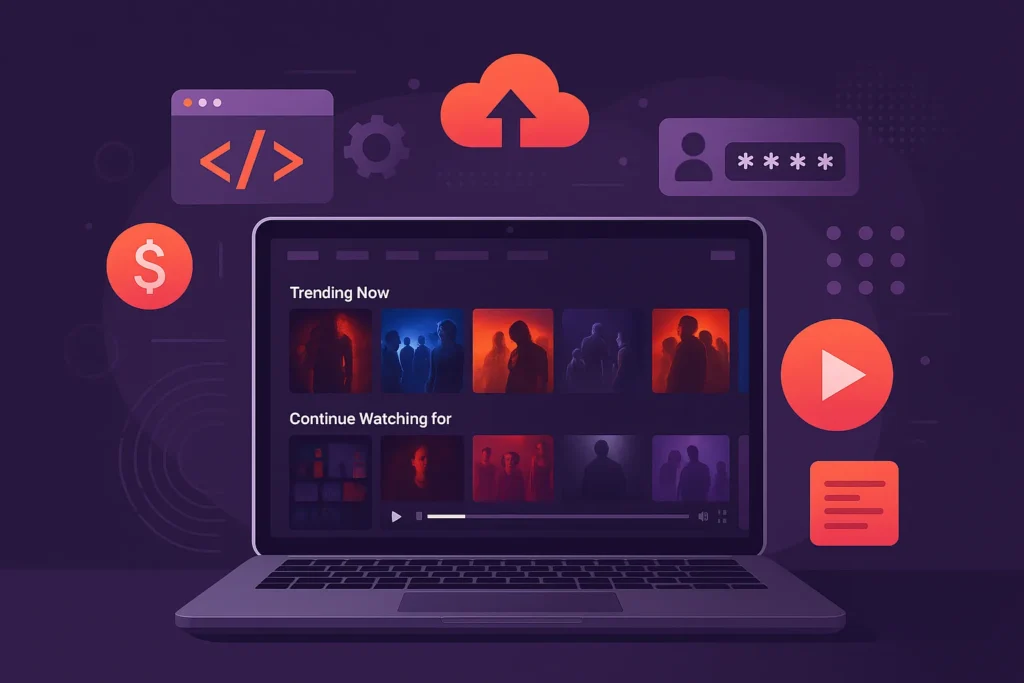In today’s digital world, social media platforms dominate the way people connect. Building social media app like Facebook has become a lucrative venture for businesses and entrepreneurs. If you’re wondering how to create a Facebook-like app, this guide will walk you through the entire process—covering everything from market trends to monetization strategies. As experts in mobile app development for social networks, Miracuves offers a full-featured solution to bring your vision to life.
With billions of users worldwide, Facebook has set the gold standard for social media apps. Building a social media app like Facebook is no small task, but with the right approach and tools, it’s possible to create a platform that engages users and offers a seamless social experience. In this guide, we’ll walk through the key steps to create a social media app that can rival Facebook’s functionality and user engagement.
Why Build a Social Media App Like Facebook?
Social media apps are thriving, with users spending more time connecting, sharing, and engaging than ever before. A Facebook-like app gives businesses and developers a chance to tap into this growing market by offering features like real-time communication, content sharing, and community building. Whether you’re looking to build a niche platform or a global social network, understanding the foundations of a social media app is crucial.
Ready to launch a social media app like facebook!
Discover how to integrate features like live video
streaming,newsfeeds,content sharing, and user
engagement tools to boost interaction and user retention.
Market Trends for Social Media Apps Like Facebook
| Trend | Description | Impact on App Development |
|---|---|---|
| Niche Social Platforms | Focused social networks catering to specific interests, communities, or professional groups | Opportunity for niche targeting |
| Increased Mobile Usage | Majority of users accessing social platforms via mobile devices | Mobile-first development focus |
| Short-Form & Interactive Content | Rise of video content, live streams, and interactive formats (polls, filters) | Drive user engagement |
| Privacy & Data Security | Users are increasingly concerned about how their data is handled and protected | Need for robust security features |
| AI-Powered Personalization | Using AI to personalize user experiences (e.g., custom news feeds, recommendations) | Enhanced engagement through AI |
Building social media apps like Facebook has become a highly sought-after venture, as the social networking space continues to see significant growth. The rise of niche platforms, such as TikTok and Clubhouse, alongside giants like Facebook, Twitter, and Instagram, highlights that there’s still room for innovation in the market. Here are some key market trends driving social media app development:
- Niche Social Platforms:
- More users are gravitating towards platforms that cater to specific interests, industries, or demographics. For example, LinkedIn focuses on professionals, while TikTok captures short-form video enthusiasts.
- These niche platforms provide opportunities for developers to target underserved markets with custom solutions.
- Increased Mobile Usage:
- Mobile usage continues to dominate, with over 90% of social media users accessing platforms via their mobile devices. As such, mobile app development for social networks has become critical for success.
- Cross-platform development frameworks like React Native and Flutter are preferred for creating scalable social media apps.
- Short-Form and Interactive Content:
- There’s been a notable rise in the popularity of short-form content, live streams, and interactive formats. Social media apps are increasingly adopting these features to increase user engagement.
- Privacy and Data Security:
- With growing concerns over privacy and data breaches, users are becoming more conscious of how their information is handled. Developers need to focus on building secure apps with transparent data policies.
- Monetization Focus:
- Social media platforms are increasingly incorporating diverse monetization strategies to boost profitability. These strategies include in-app purchases, subscription models, and influencer-driven marketing.
- AI-Powered Personalization:
- The use of AI in social media apps to offer personalized user experiences is on the rise. Features like personalized news feeds, targeted content recommendations, and chatbot-powered customer service are becoming the norm.
Let’s visualize these trends with a chart:
Chart: Key Market Trends Driving Social Media App Development

Types of Social Media Apps
Social media apps come in various forms, each catering to different user needs and interactions. Here are the primary types of social media apps:
- Social Networking Apps
These are the most common types of social media apps, focused on building connections between people. Users can create profiles, send friend requests, and interact via messages and posts.- Examples: Facebook, LinkedIn, Twitter
- Features: News feed, friend lists, chat, and status updates.
- Media Sharing Apps
These apps are designed for users to share multimedia content such as photos, videos, and music. Media sharing apps often incorporate tools for editing and enhancing content before it is posted.- Examples: Instagram, YouTube, TikTok
- Features: Photo/video sharing, filters, live streaming, and comments.
- Microblogging Apps
Microblogging platforms allow users to post short updates, thoughts, or links. These apps are often used for real-time communication and breaking news.- Examples: Twitter, Tumblr
- Features: Short posts, hashtags, and real-time updates.
- Discussion Forums
These platforms are designed for users to have discussions, ask questions, and share knowledge on various topics.- Examples: Reddit, Quora
- Features: Threaded discussions, voting, and topic-based forums.
- Social Messaging Apps
Social messaging apps enable one-on-one or group conversations. Many social networking platforms integrate messaging into their core functionality, but standalone messaging apps also exist.- Examples: WhatsApp, Facebook Messenger, Telegram
- Features: Text, voice, and video chat, group messaging, and file sharing.
- Professional Networking Apps
These apps focus on building business connections, sharing professional experiences, and career development. They are used for job hunting, networking, and recruitment.- Examples: LinkedIn, Xing
- Features: Professional profiles, job listings, and recommendations.
- Anonymous Social Media Apps
These platforms allow users to interact and post content anonymously. They are often used for confessions, secrets, or honest feedback.- Examples: Whisper, Yik Yak
- Features: Anonymous posts, location-based feeds, and voting.
- Interest-Based Social Communities
These platforms connect users based on shared interests, hobbies, or passions. Users can join specific groups or forums and engage with like-minded people.- Examples: Goodreads (for books), Strava (for fitness), Behance (for design)
- Features: Interest-based groups, user-generated content, and recommendations.
- Social Commerce Apps
Social commerce apps blend social interaction with online shopping. Users can follow brands, shop for products, and even share their purchases with friends.- Examples: Pinterest, Instagram Shopping
- Features: Shopping tags, product recommendations, and social sharing.
- Dating Apps
Dating apps are designed to help users meet potential romantic partners based on mutual interests or preferences.- Examples: Tinder, Bumble
- Features: Swiping, matching algorithms, and private messaging.
- Review and Recommendation Apps
These platforms allow users to share reviews, rate products, and recommend services or experiences to others.- Examples: Yelp, TripAdvisor
- Features: Reviews, ratings, and user-generated recommendations.
- Live Streaming Apps
These apps focus on live broadcasting content to users, who can watch, interact via comments, and send virtual gifts.- Examples: Twitch, YouNow
- Features: Live video streaming, real-time interaction, and monetization options for creators.
Each type of social media app serves different purposes and user demographics, from casual social interaction to professional networking or content sharing. Understanding these categories can help developers decide on the features and target audience when building a new social media platform.
Also Read “Decoding X (Twitter): A Deep Dive into Its Revenue Streams and Business Model“
Steps to Building a Social Media App Like Facebook
Step 1: Market Research and Defining Your Niche
Before diving into development, the first and most important step is thorough market research. Facebook caters to a broad audience, but today’s successful social media apps often target specific niches (e.g., professional networking, travel enthusiasts, etc.).
Key Considerations:
- Identify your audience: Who is your app for? (e.g., Gen Z, professionals, hobbyists)
- Competitor analysis: What are other platforms offering? What gaps can you fill?
- Feature research: What are the must-have features that will drive user engagement?
Step 2: Core Features of a Social Media App Like Facebook
A successful social media app needs certain core features to engage users and keep them coming back. Here are some features to consider:
- User Profiles and Authentication
- Allow users to create personalized profiles with photos, bios, and status updates.
- Implement secure user authentication via email, phone, or social media logins.
- News Feed and Timeline
- Create a dynamic news feed where users can see updates, posts, and activities from their friends.
- Implement an algorithm to personalize the feed based on user preferences and interactions.
- Friendship & Connection Features
- Enable users to add friends, send friend requests, and manage their contact lists.
- Consider adding options for groups, events, or communities to foster deeper connections.
- Messaging and Chat Functionality
- Develop real-time messaging functionality, similar to Facebook Messenger, where users can chat one-on-one or in groups.
- Include multimedia sharing (photos, videos, and audio).
- Content Sharing (Text, Photos, Videos)
- Allow users to post status updates, share photos, videos, and links on their timeline or in groups.
- Implement privacy settings so users can control who sees their content.
- Push Notifications
- Set up push notifications to alert users about friend requests, messages, comments, likes, and more.
| Feature | Description | Importance |
|---|---|---|
| User Profiles & Authentication | Secure user login, customizable profiles, with photos, bios, and status updates | Essential |
| News Feed & Timeline | A personalized feed showing posts, updates, and activities from connections | Critical for engagement |
| Friendship & Connection Features | Friend requests, groups, events, and communities for building user networks | Core to social apps |
| Messaging & Chat | Real-time, private or group messaging with multimedia sharing | High priority |
| Content Sharing | Ability to share text, photos, and videos on the timeline or in groups | Vital for interaction |
| Push Notifications | Alerts for new messages, likes, comments, and other user activities | Enhances engagement |
Step 3: Tech Stack Selection and Backend Development
To build a robust social media app like Facebook, you’ll need to choose the right technology stack for both the front-end and back-end.
Suggested Tech Stack:
- Front-End: React Native, Flutter (cross-platform mobile development)
- Back-End: Node.js, Python, or Ruby on Rails for server-side development
- Database: MySQL, PostgreSQL, or MongoDB for handling large volumes of user data
- Hosting: AWS, Google Cloud, or Microsoft Azure for scalable cloud hosting
Real-Time Features:
Implement real-time chat and news feed updates using technologies like WebSockets or Firebase for seamless communication and data syncing.
To enable real-time messaging and notifications, technologies like WebSockets can be implemented to ensure smooth and instant data synchronization.
Step 4: Design and User Experience (UX/UI)
Creating a visually appealing and intuitive user interface (UI) is crucial for any social media app. Focus on clean design, simple navigation, and responsive layouts that work across devices.
Key UX/UI Principles:
- Simplicity: Make sure the app is easy to use and navigate.
- Engagement: Use notifications, badges, and easy-to-access sharing options to encourage frequent interaction.
- Responsiveness: Ensure your app works flawlessly on both iOS and Android devices.
Consider using wireframing tools like Sketch or Figma to prototype your app before development.
Step 5: Development and Testing
After the design is finalized, it’s time to move to the development phase. Building the front-end and back-end, integrating databases, and ensuring seamless functionality are critical steps in this process.
Key Stages:
- Front-end development: Implement user interface designs and connect with the backend.
- Back-end development: Focus on setting up user authentication, data storage, and messaging functionalities.
- Testing: Perform extensive testing to identify bugs and usability issues. Use real-time beta testing platforms to gather feedback from potential users.
Step 6: Monetization Strategies for Social Media Apps
Monetizing your app like Facebook is essential for long-term success. Consider various monetization models, such as:
- Ad Revenue: Partner with advertisers to show ads on your app.
- Subscription Models: Offer premium features to users through a subscription model.
- In-App Purchases: Allow users to buy virtual goods or additional features.
- Affiliate Marketing: Promote third-party services and earn a commission.
Step 7: Launching and Marketing Your App
Once development is complete and testing is done, it’s time to launch your app. The success of your social media app heavily depends on your marketing strategy.
Key Steps:
- Pre-launch buzz: Create excitement by announcing the launch across multiple channels.
- Influencer marketing: Collaborate with influencers in your niche to promote your app.
- User feedback: Encourage early users to provide feedback for continuous improvements.
Also Read “Dating App Development: A Comprehensive Guide to Building Your Own Platform“
Cost of Developing a Social Media App Like Facebook
Developing a social media app like Facebook involves a wide range of costs, depending on various factors like features, platform, and development time. Below is an overview of the typical development costs based on the social media app development process.
Key Cost Factors:
- App Features: The more complex the features (e.g., real-time messaging, video streaming, AI-based feed algorithms), the higher the cost.
- Platform: Developing for both iOS and Android will naturally increase the costs compared to building for just one platform.
- Development Time: Depending on the project scope, development time can range from several months to a year or more.
- Design: A well-designed user interface (UI) that enhances user engagement requires careful planning and execution, affecting the overall cost.
- Testing and Maintenance: Ongoing testing, bug fixes, and feature updates will add to the long-term costs of the app.
Here’s an estimated cost breakdown for developing a Facebook-like social media app:
| Development Stage | Estimated Cost |
|---|---|
| Planning & Market Research | $2,000 – $5,000 |
| UI/UX Design | $3,000 – $7,000 |
| Frontend Development | $15,000 – $25,000 |
| Backend Development | $20,000 – $30,000 |
| Database Setup & Integration | $3,000 – $10,000 |
| Real-time Messaging/Notifications | $5,000 – $15,000 |
| User Authentication & Security | $3,000 – $7,000 |
| Social Features (Feed, Profiles) | $10,000 – $20,000 |
| Testing & QA | $3,000 – $10,000 |
| Launch & Deployment | $1,000 – $3,000 |
| Total Estimated Cost | $65,000 – $132,000 |
Miracuves Solution Pricing for FB Like App
For businesses or entrepreneurs looking for a cost-effective solution, Miracuves offers a complete social media app solution with both web and mobile apps for just $2,199. This includes essential features like user profiles, news feed, messaging, and more, all tailored to your specific needs.
Our solution provides a ready-made platform that’s customizable, allowing you to launch your app quickly and efficiently without the heavy costs of custom development.
Get in touch with Miracuves today to start building your social media app!

Possible Market Penetration Strategies
Despite the challenges, there are effective strategies to penetrate the competitive social media market. Here are some strategies for how to create a Facebook-like app and gain traction:
- Leverage Niche Markets:
- Rather than trying to compete directly with giants like Facebook, focus on niche markets or underserved audiences. By tailoring the app’s features and community-building tools to a specific interest group (e.g., professionals, hobbyists, or local communities), you can carve out a dedicated user base.
- Example: LinkedIn’s focus on professional networking.
- Innovative Features:
- Integrating cutting-edge features like AI-powered personalization, AR filters, or blockchain for enhanced privacy can set your app apart. Users are always seeking new ways to engage with social media platforms, so offering something unique will increase user retention and acquisition.
- Example: TikTok’s short-form video format revolutionized how users engage with content.
- Referral and Incentive Programs:
- Implementing referral programs or offering incentives like discounts or in-app rewards can encourage users to invite friends and grow your user base organically. Gamification can also increase user engagement.
- Example: WhatsApp’s early referral programs helped them grow significantly in the initial stages.
- Influencer and Community Partnerships:
- Collaborating with influencers who can promote your app to their large following is an effective strategy. Additionally, partnering with communities or organizations can help you tap into a ready-made audience.
- Example: Clubhouse grew rapidly by collaborating with industry leaders and influencers.
- Freemium Model:
- Offering a freemium model with essential features for free while charging for premium features can help drive initial user adoption. Once users become accustomed to the platform, they may be more willing to pay for extra features or services.
- Example: LinkedIn’s free and premium tiers.
- Localized Marketing:
- Focus on penetrating local markets first by tailoring your app’s language, content, and features to specific regions or demographics. Once you’ve established a strong foothold locally, you can expand to a broader market.
- Example: Facebook’s early success came from focusing initially on specific colleges and expanding from there.
- Focus on Mobile-First Experience:
- As mobile continues to dominate, ensuring your app provides a seamless mobile-first experience can greatly improve user engagement. Optimizing for quick load times, intuitive design, and ease of use will enhance the user experience and increase retention rates.
- Example: Instagram’s success hinged on being a mobile-first platform with a focus on photos.
- Data-Driven Insights:
- Use data analytics to continually assess user behavior, preferences, and pain points. This allows for real-time improvements and personalization, increasing user satisfaction and retention.
- Example: Facebook’s algorithm learns from user interactions to provide a personalized feed, keeping users engaged.
By addressing these challenges and applying effective market penetration strategies, developers and businesses can create a social media platform that stands out in the competitive landscape, driving growth and ensuring user loyalty.
Revenue Model for Social Media Apps Like Facebook
| Revenue Model | Description | Examples |
|---|---|---|
| Ad-Based Revenue | Generate income through in-feed ads, story ads, or banner ads | Facebook, Instagram |
| Subscription Model | Offer premium services or ad-free experiences for a subscription fee | LinkedIn Premium, YouTube Premium |
| In-App Purchases | Allow users to purchase virtual goods, stickers, or customizations | Snapchat Filters, Facebook Stars |
| Affiliate Marketing | Promote products or services from third parties and earn commissions | Influencer-driven product endorsements |
| Freemium Model | Offer a free version with basic features and a paid version with more advanced features | LinkedIn, Dropbox |
| User Data Monetization | Monetize anonymized user data for market research, targeted advertising, or analytics | Facebook’s targeted advertising algorithms |
Building a social media app like Facebook requires a well-defined revenue model to ensure long-term profitability. Here are some of the most common monetization strategies for social platforms:
- Ad-Based Revenue:
- The most common revenue model for social media apps, this involves generating revenue through targeted advertisements. Ads can be displayed in users’ feeds, stories, or other engagement areas. Facebook’s advertising model is highly effective due to its data-driven targeting, allowing advertisers to reach specific demographics.
- Subscription-Based Model:
- Some social media platforms offer premium features through subscription services. This may include ad-free experiences, enhanced privacy features, or access to exclusive content. This model works particularly well for niche platforms where users are willing to pay for value-added services.
- In-App Purchases:
- In-app purchases offer users the ability to buy virtual goods, stickers, or other customizations that enhance their experience. For instance, apps like Snapchat and Instagram often sell filters or effects as in-app purchases.
- Affiliate Marketing:
- Social media apps can partner with businesses to promote products and earn commissions through affiliate marketing. Influencers and content creators often play a key role in this strategy by sharing sponsored posts or links with their followers.
- Freemium Model:
- Many apps offer a free version with basic features and a paid version with advanced features. This freemium model allows users to try the app before committing to a subscription or one-time purchase.
- User Data Monetization:
- While more controversial, some platforms monetize user data by selling anonymized information to third-party companies for market research and analytics. However, data privacy laws are increasingly regulating this strategy.
By adopting a combination of these monetization strategies for social platforms, developers can build sustainable revenue streams and encourage user engagement.

Competitor Analysis for Social Media Apps Like Facebook
When building a social media app like Facebook, it’s essential to understand the competitive landscape. Social media is dominated by both large, established players and emerging niche platforms. Conducting a competitor analysis will help identify opportunities, strengths, and weaknesses that can be leveraged to position your app effectively in the market.
Here’s a detailed competitor analysis of major social media platforms that are shaping the industry:
- Facebook:
- Strengths: Facebook remains the largest social media platform with billions of users, offering comprehensive features such as messaging, news feed, marketplace, and video streaming. It has a mature advertising platform with advanced targeting capabilities.
- Weaknesses: Concerns about data privacy and security have damaged Facebook’s reputation in recent years. The platform also faces saturation, with younger demographics migrating to newer platforms.
- Instagram:
- Strengths: Instagram focuses on visual content, with strong engagement features like Stories, IGTV, and Reels. It appeals to younger audiences and has successfully integrated eCommerce through features like shopping tags.
- Weaknesses: Instagram’s heavy emphasis on curated, visual content can limit its appeal to those seeking deeper connections or more text-based engagement.
- TikTok:
- Strengths: TikTok’s short-form video content and advanced algorithm for content discovery have made it extremely popular, especially among Gen Z users. Its interactive features and viral challenges drive high user engagement.
- Weaknesses: Limited long-form content and its appeal primarily to younger audiences make it less attractive for professional or older users.
- LinkedIn:
- Strengths: LinkedIn dominates the professional networking space, providing tools for career development, recruitment, and business connections. It offers a premium subscription model for added features and insights.
- Weaknesses: It lacks the entertainment and casual social interaction features found on other platforms, limiting its appeal to non-professional use.
- Twitter:
- Strengths: Twitter is known for its real-time updates and is widely used for news, public discourse, and live events. Its simplicity and open platform encourage high interaction and viral content sharing.
- Weaknesses: Twitter has faced challenges with user harassment and content moderation. Additionally, it struggles to retain new users as its growth has plateaued in recent years.
- Snapchat:
- Strengths: Snapchat pioneered the ephemeral messaging format and has a highly engaged user base for its AR filters and Stories feature. Its younger audience prefers its private, disappearing messages over more permanent posts.
- Weaknesses: Snapchat’s limited focus on messaging and stories makes it less versatile compared to more comprehensive platforms like Facebook and Instagram.
Competitor Comparison Table
| Platform | Key Features | Target Audience | Strengths | Weaknesses |
|---|---|---|---|---|
| News Feed, Messenger, Marketplace, Video, Ads | All demographics | Massive user base, versatile features, advanced ad platform | Privacy concerns, user saturation, younger user decline | |
| Stories, Reels, IGTV, Shopping Tags | Millennials, Gen Z | Visual engagement, strong eCommerce integration | Limited text-based interaction, curated content focus | |
| TikTok | Short-form video, Viral challenges, Content discovery | Gen Z, Millennials | Highly engaging short videos, viral potential | Limited long-form content, narrow age appeal |
| Professional networking, Job postings, Premium features | Professionals, Businesses | Dominates professional space, recruitment tools | Limited entertainment, casual engagement | |
| Real-time updates, News, Public discourse | Broad, News enthusiasts | Quick, open platform for live events, news | User retention, harassment and content moderation | |
| Snapchat | Ephemeral messaging, Stories, AR filters | Gen Z, Teenagers | Popular with younger users, unique AR and messaging features | Limited features outside messaging and stories |
Key Takeaways:
- Facebook offers the most comprehensive feature set but is challenged by user saturation and privacy concerns.
- Instagram and TikTok excel in visual and video-based content, with strong engagement from younger demographics.
- LinkedIn is unbeatable in professional networking, while Twitter thrives in real-time news and conversations.
- Snapchat caters to a younger audience with its focus on disappearing messages and AR filters, but its features are limited compared to Facebook and Instagram.
Also Read “Building Connections: How to Develop a Hinge Clone for Your Dating App“
Challenges in Building a Social Media App Like Facebook
Creating a social media app like Facebook is a rewarding but challenging task. Below are some of the most common challenges developers and entrepreneurs face during the social media app development process:
- High Competition:
- The social media space is saturated with well-established players like Facebook, Instagram, and TikTok. Gaining traction in this crowded market can be difficult, especially when competing against platforms with billions of users.
- User Retention:
- Building an app is only the first step; keeping users engaged and returning to your platform is a significant challenge. Developing user engagement strategies for social media, such as personalized feeds, frequent updates, and gamification, is key to long-term success.
- Scalability:
- As your user base grows, your infrastructure needs to handle increased traffic and data load. Ensuring that your app is scalable, with a flexible backend and optimized social media app tech stack, is crucial for future growth.
- Security and Privacy:
- Users are becoming more aware of data privacy, and with the implementation of stringent regulations (such as GDPR), ensuring data security is a challenge. You’ll need to invest heavily in security measures to safeguard user data. Ensuring compliance with data protection regulations like the GDPR is critical for protecting user data and avoiding hefty fines.
- Monetization:
- Implementing effective monetization strategies for social platforms without alienating users can be tricky. Too many ads or paywalls can drive users away, so balancing user experience and revenue generation is essential.
- User Acquisition:
- Acquiring new users for a social platform is an ongoing challenge. It requires robust marketing efforts, partnerships, and unique value propositions that differentiate your app from existing giants.
- Cross-Platform Consistency:
- Ensuring that your app provides a consistent experience across multiple platforms (iOS, Android, Web) is challenging, especially when it comes to performance, design, and features.
| Challenge | Description | Impact on Development |
|---|---|---|
| High Competition | Competing with giants like Facebook, Instagram, and TikTok | Need for unique features and positioning |
| User Retention | Keeping users engaged and ensuring they return regularly to the app | Key for long-term success |
| Scalability | Ensuring the app can handle a growing user base and traffic | Critical for performance at scale |
| Security and Privacy | Safeguarding user data and complying with regulations like GDPR | Essential for trust |
| Monetization | Implementing revenue models without disrupting user experience | Balancing user engagement and revenue |
| User Acquisition | Attracting new users in a competitive space | Important for initial growth |
| Cross-Platform Consistency | Ensuring a seamless experience across iOS, Android, and web | Vital for user satisfaction |
Conclusion: Why You Need an Expert to Build Your Social Media App
Building a social media app like Facebook is a complex process that requires a deep understanding of both the technical and business aspects. From identifying your audience and implementing core features to selecting the right tech stack, it’s essential to approach this project with expertise.
At Miracuves, we specialize in creating cutting-edge social media apps tailored to your unique needs. Whether you’re building a niche platform or a large-scale social network, we can help you bring your vision to life. Contact us today to discuss how we can develop your next big social media app!
Want to see the platform in action?
Book a live demo of our social media app that integrates messaging, video sharing, and user interaction tools to create a connected, engaging experience.
FAQ
How Much Does It Cost to Build a Social Media App Like Facebook?
The cost to build a social media app like Facebook can range between $65,000 to $132,000, depending on factors like features, platform choice (iOS, Android, or both), design complexity, and development time. This includes costs for UI/UX design, front-end and back-end development, database setup, messaging systems, and ongoing testing. Alternatively, solutions like Miracuves offer a ready-made app for just $2,199, including both web and mobile versions.
What Features Should a Social Media App Like Facebook Have?
To create a competitive social media app, you should include the following features:
User Profiles & Authentication: Secure login and profile management.
News Feed & Timeline: Personalized content feed.
Messaging: Real-time chat and group messaging.
Content Sharing: Ability to post text, photos, and videos.
Push Notifications: Alerts for messages, comments, and likes.
Monetization Options: In-app purchases, ads, or premium subscriptions. These features are essential for keeping users engaged and returning to the platform.
What Tech Stack is Best for Developing a Social Media App?
The ideal social media app tech stack for building a scalable and high-performance app includes:
Front-End: React Native or Flutter for cross-platform mobile development.
Back-End: Node.js, Python, or Ruby on Rails for server-side development.
Database: MySQL, PostgreSQL, or MongoDB to store user data efficiently.
Cloud Hosting: AWS, Google Cloud, or Microsoft Azure for scalable infrastructure. These technologies allow for real-time messaging, robust user authentication, and smooth performance across devices.
How Do You Monetize a Social Media App Like Facebook?
Social media apps typically use several monetization strategies, including:
Advertising: Selling ad space to brands based on user data.
Subscription Models: Offering premium features through monthly or yearly subscriptions.
In-App Purchases: Selling virtual goods, filters, or customizations.
Affiliate Marketing: Partnering with brands for product promotion through influencers. Finding the right balance between user experience and monetization is crucial for long-term success.
What Are the Challenges in Building a Social Media App Like Facebook?
The biggest challenges when building a social media app like Facebook include:
High Competition: Competing with giants like Facebook, Instagram, and TikTok.
User Retention: Ensuring users stay engaged and continue using the app.
Scalability: Handling increasing numbers of users and data loads.
Privacy and Security: Ensuring data protection and compliance with regulations.
Monetization: Implementing effective revenue strategies without alienating users. Overcoming these challenges requires a solid development and marketing strategy.
What Are the Key Market Trends for Social Media Apps in 2024?
The most important market trends for social media apps in 2024 include:
Niche Platforms: Focusing on specific audiences or communities.
Increased Mobile Usage: Optimizing apps for mobile-first users.
Interactive Content: Emphasizing short-form video, live streams, and user interaction.
Privacy & Data Security: Addressing growing concerns around user data privacy.
AI-Powered Personalization: Using AI to tailor the user experience with personalized feeds and recommendations. These trends are shaping the future of social media, and incorporating them into your app can improve user engagement and market penetration.
Unlock your social and communication potential with Miracuves – crafted for connection, interaction, and engagement in the digital age:
- Facebook Like App – A community-driven app that connects users, enables sharing, and fosters online engagement through posts, groups, and messaging.
- LinkedIn Like App – A professional networking app built for career growth, job connections, and industry insights.
- Twitter Like App – A microblogging app enabling real-time updates, trending discussions, and direct audience interaction.
- Tinder Like App – A matchmaking app designed for discovering connections, swiping through profiles, and starting new conversations with ease.







